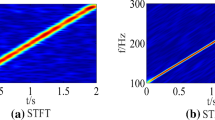Abstract
It is well know that under water vehicles emit many types of acoustic signals, including stationary as well as non-stationary. The non-stationary transient signals are receiving considerable attention, especially from the standpoint of detection and tracking of under water vehicles. Thus, modern methods for processing these non-stationary acoustic transient signals are required. This paper presents a very powerful method for analyzing acoustic transient signals, the positive time-frequency distribution. A fast algorithm that implements the minimum cross-entropy positive time-frequency distribution makes practical the processing of ''real world data'', like under water vehicle acoustic transient signals. An example of such a signal is presented, which is a generic acoustic transient signal from a under water vehicle. The signal is only representative, as it is normalized in time, in frequency, and in amplitude. The positive time-frequency distribution constructed for this generic transient signal is contrasted with the one-third octave method, which is currently the primary method being used by the under water vehicle community to analyze under water vehicle transients. The positive distribution is also contrasted with broad band and narrow band spectrograms.
Similar content being viewed by others
References
L. Cohen, “Generalized Phase–Space Distribution Function,” J. Math. Phys., vol. 7 no. 5, 1966, pp. 781–786.
L. Cohen, and T. Posch, “Positive Time–Frequency Distribution Functions,” IEEE Trans. Acoust, Speech Signal Processing, vol. ASSP–33, no. 1, 1985, pp. 31–38.
L. Cohen, and Y. Zaparovanny, “Positive Quantum Joint Distributions,” J. Math. Phys., vol. 21, no. 4, 1980, pp. 794–796.
P. Loughlin, J. Pitton, and L. Atlas, “Construction of Positive TFDs,” IEEE Trans. Sig. Proc., vol. 42, no. 10, 1994, pp. 2697–2705.
D. Groutage, “Fast Algorithm for Computing Minimum Cross–Entropy Positive Time–Frequency Distribution,” IEEE Trans. Sig. Proc., vol. 45, no. 8, August 1997.
Author information
Authors and Affiliations
Rights and permissions
About this article
Cite this article
Groutage, D. The Analysis of Under Water Vehicle Non-Stationary Acoustic Transient Signals Using a New Fast Algorithm for Constructing Positive Time-Frequency Distributions. Multidimensional Systems and Signal Processing 9, 383–389 (1998). https://doi.org/10.1023/A:1008458323991
Issue Date:
DOI: https://doi.org/10.1023/A:1008458323991




